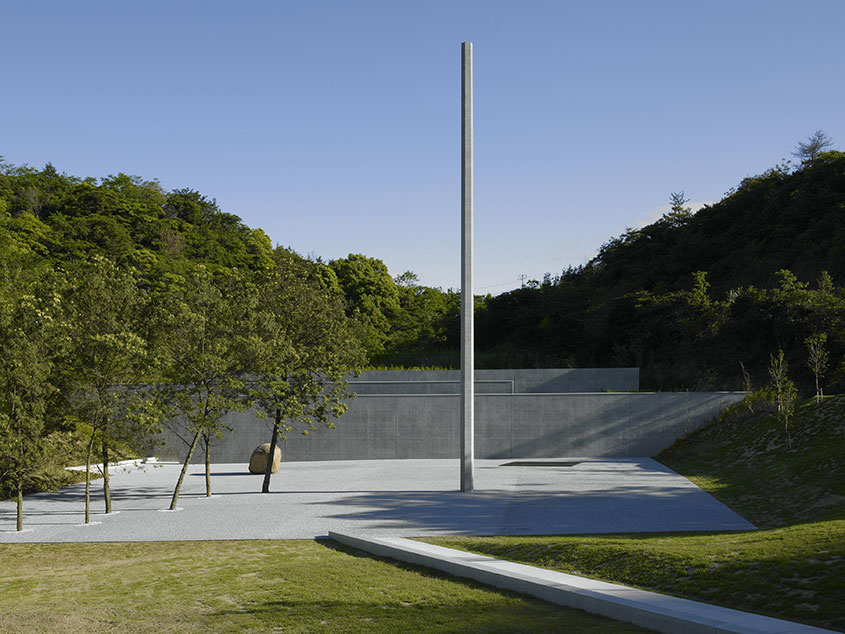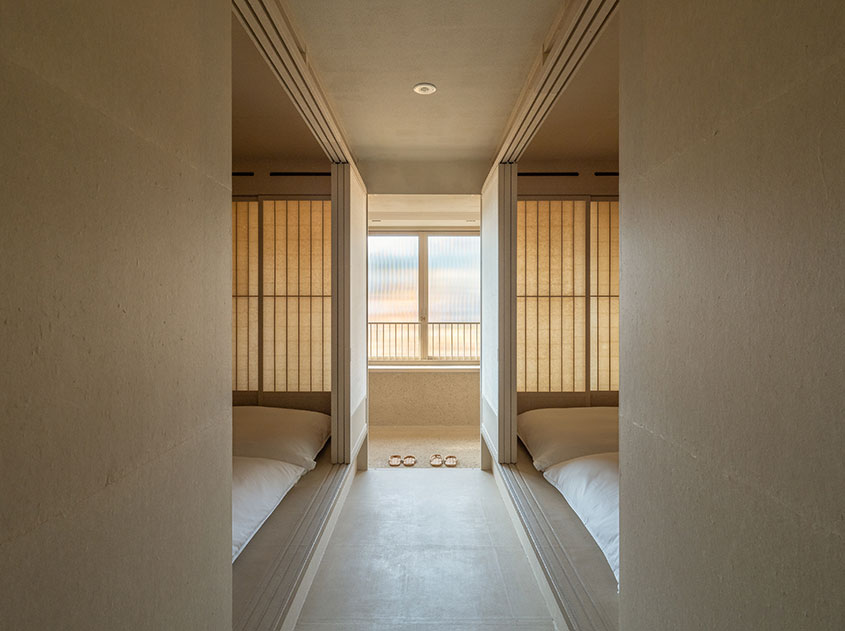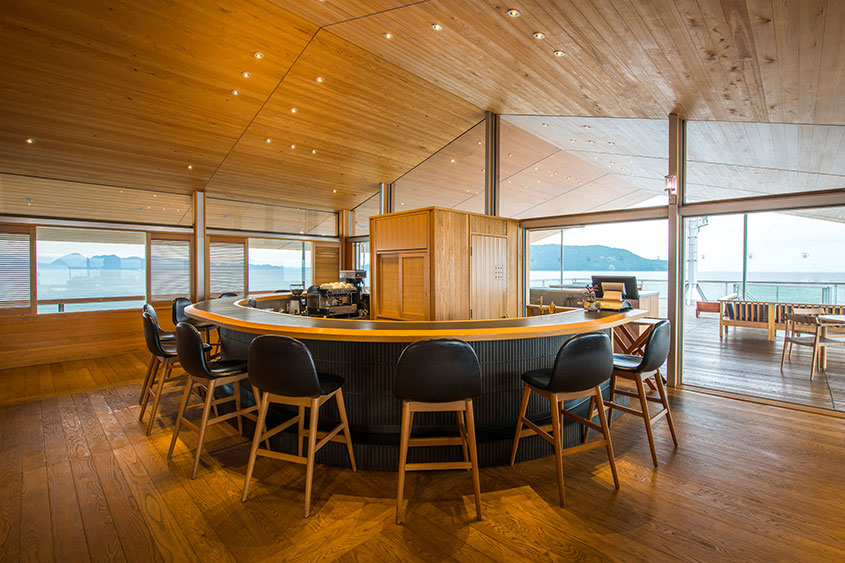Art Museums, Dining and Lodging: Exploring Architecture’s Many Roles
Tour Guide
Words by Mari Hashimoto

Benesse Art Site Naoshima
From the 1970s onwards, Naoshima Town asked the architect Kazuhiro Ishii to design several public buildings, including the town office and educational facilities like a kindergarten and junior high school, with this forming the basis of Naoshima’s association with architecture.
Thereafter, Tetsuhiko Fukutake, founding president of Fukutake Publishing, and Chikatsugu Miyake, then mayor of Naoshima, teamed up to develop a cultural and educational area on the island. In 1989, Naoshima International Camp (now located in Benesse Park) was launched under the supervision of Tadao Ando. This provided the impetus for further initiatives, with Benesse House then opening in 1992 as a facility integrating a museum with a hotel, based on the concept of the “coexistence of nature, art and architecture.” The scope of these activities expanded thereafter to include site-specific installations and projects in local villages in Naoshima and in the 2000s the initiative expanded to nearby islands like Teshima and Inujima. Since 2010, meanwhile, Naoshima, Teshima, Inujima and four other islands have staged the Setouchi Triennale, a contemporary art festival held once every three years.
Naoshima is now home to numerous art museums, galleries and art projects, including Chichu Art Museum, Benesse House Museum, Hiroshi Sugimoto Gallery: Time Corridors, Lee Ufan Museum, Art House Project, ANDO MUSEUM, Setouchi" "Archive/Miyanoura Gallery 6, Naoshima Bath “I♥湯”(I love YU), The Naoshima Plan “The Water”, and Valley Gallery. Benesse House also offers four types of accommodation: Museum, Oval, Park, and Beach. Some facilities require online reservations, so please check the websites for details.

Photo:Tadasu Yamamoto



Photo:Tadasu Yamamoto
Benesse Art Site Naoshima
- Time
- Please check the official website for the open days calendar, as it varies for each island and facility; in addition, some facilities require advance reservations.
- Closed
- Please check the website's open days calendar, as it varies for each island and facility.
- Admissions
- Please check the website as it varies for each facility.
- Link
- https://benesse-artsite.jp/en/
Shikokumura Museum
Located on an expansive site in the foothills of Mount Yashima, Kagawa Prefecture, this outdoor museum houses 33 relocated and restored historic buildings and traditional kominka houses from the 18th to the 20th century. In 2022, the museum reopened following renovation work and the completion of the new entrance building Oyanesan (designed by Yoshiyuki Kawazoe), with a new explanatory video and audio guide also available to enhance the visiting experience. Udon and other local specialties are served near the entrance at Shikokumura Waraya, a complex made up of traditional thatched houses from the late 19th century originally located in Tokushima Prefecture and Kagawa Prefecture. Another facility is the Shikokumura Café. This Registered Tangible Cultural Property was originally built in 1905 to serve as an ijinkan (foreign residence). While the buildings in the village were all relocated from Shikoku, Shikokumura Café was relocated from Kobe, Hyogo Prefecture, so it sits outside the village itself. The café’s furnishings are all of similar antiquity and were originally brought over from Victorian Britain.




Shikokumura Museum
- Place
- 91 Yashima Nakamachi, Takamatsu, Kagawa, 761-0112
- Time
- 9:30 am to 5:00 pm (Last entry 4:30 pm)
*Some facilities, including the Shikoku Mura Gallery, close at 4:30 pm. - Closed
- Tuesdays (closed the following day if Tuesday is a national holiday).
*Museum is subject to temporary closure for maintenance or inclement weather. - Admissions
- Adults
¥1,600 (¥1,400)
University Students (w/ ID)
¥1,000 (¥800)
High School/Jr. High School
¥600 (¥400)
Elementary School & Under
Free
*Fees in parentheses are for groups of fifteen or more
*University students must show school ID.
*Discounts for those with disabilities are available.
*We offer a 50% discount for those displaying a disability certificate, medical rehabilitation certificate, mental disability certificate, or Mirairo ID and for one accompanying caregiver.
*There is no senior citizen discount. - Link
- https://www.shikokumura.or.jp/en/
LOG
LOG is a multi-purpose facility in Onomichi, a city that still retains the kind of scenery that movie afficionados might recognize from Yasujirō Ozu’s Tokyo Story. Located near Naoya Shiga’s former residence, where the writer conceived the idea for A Dark Night’s Passing, LOG was originally an apartment block constructed in 1963. After a major conversion project, the building’s name was changed to LOG. This stands for “Lantern Onomichi Garden,” a name that reflects the building’s new role not only as a hotel but also as a site of facilities open to the public that spread awareness of Onomichi’s nature and culture. LOG also marks the first time the Indian architecture group STUDIO MUMBAI has worked on a construction project outside of India. Breakfast and dinner are provided in the dining area, with the menus supervised by the food artist Ai Hosokawa. Nearby Setouchi Minato no Yado also offers accommodation. Here, visitors can rent out entire wings in Shimazui Manor, named after the wealthy merchant who once owned the building, or entire floors in Izumo House, which served as a district office for Matsue Domain (Shimane prefecture) officials during the Edo period (1603–1868).




LOG
- Place
- 11-12 Higashi Tsuchido-cho, Onomichi City, Hiroshima Prefecture 722-0033
- Link
- https://l-og.jp/en/
guntû
guntû is a cruise ship that sails from Bella Vista Marina in Onomichi City, Hiroshima Prefecture. Designed by Yasushi Horibe, the ship first set sail in 2017. All 19 cabins are equipped with terraces. The guntû Suite is located in the bow, once the site of the control room, and it is the only cabin with an unobstructed view of way ahead. guntû’s has three categories of routes – westward, central and eastward – with each voyage offering different themes and contents depending on the season. Cruises are usually two to three nights and they are all-inclusive. The ship doesn’t call at any harbor during the cruise, instead anchoring at night in bays or close to islands. Overlooking guntû’s home port is Bella Vista Spa & Marina Onomichi. Originally the guest house of a shipbuilding company, the building was remodeled by architect Hiroshi Nakamura and was transformed into a luxury resort hotel that still retains the traditions and welcoming omotenashi spirit of its former incarnation.




guntû
- Place
- 1364-6 Urasaki-cho, Onomichi, Hiroshima, 720-0551, Japan
- Link
- https://guntu.jp/en/

